Dynamic Range (JPEG)
Our Dynamic Range measurement system is related to shooting
a calibrated Stouffer Step Wedge (a total of 13 stops in the range) which a
backlight is using a daylight balanced lamp (98CRI). A single shooting will
generate a gray scale range from cropping white point down to black of the
camera (example given below). Each step of the scale is equivalent to 1/3 EV (a
third of a stop), we opt for one step as 'middle gray' (defined at the brightness
of 50%) and measure outwards to define the dynamic range. Therefore, there will
be 'two sides' of the results we present, the amount of shadow range (below
middle gray) and the amount of brightness range (above middle gray).

Dynamic Range
measurement scale
To most people, the lighting range is the first thing they
think about when it comes to the dynamic range, which is the amount of
highlight detail above middle gray the camera can shoot before it trims to
white. The shadow range is more complicated, in our test the line on the chart
will stop as soon as the luminance value drops to a pre-defined 'black point'
(about 2% luminance) or the ratio of signal-to-noise drops below a predefined
value (where shadow detail will be obscured by noise), all depending on what
happens first.
Note: This page uses our interactive dynamic range
comparison widget. The wedges below the chart are made by our measurement
system from the values read from the step wedge; the red lines show light and
dark range approximation (the dotted line representing middle gray).
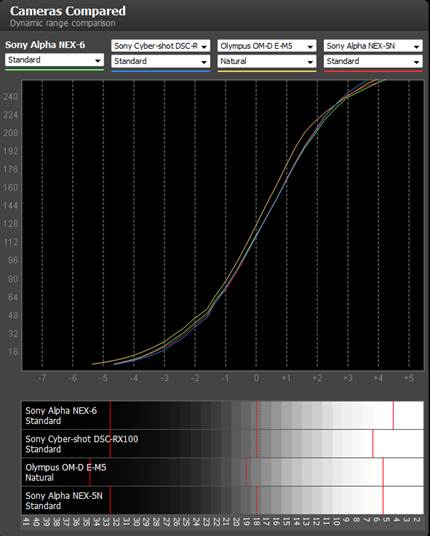
The graph is to
compare the dynamic range.
The most important thing to note in this graph is the curve
at the top of the light range. The gentleness of the curve illustrates the
NEX-6’s ability to give highlights with a more pleasant curve to 100%
brightness instead of cropping out. As you can see the 6's default tone curve
is the same as the 5N as well as other recent cameras of Sony. The 6's dynamic
range performance is at the top of its camera series, especially when compared
to the Micro Four Thirds camera.
Color modes

The graph is to
compare the color modes.
The NEX-6 comes with a range of color modes that have a
relatively low effect on contrast - Vivid, Landscape, and B&W all produce
images with slightly higher contrast over the example, but with basically the
same brightness range. The portrait mode reduces the overall contrast which is
useful for creating smooth facial contours without the harsh dark features.
DRO settings

The comparison of
the DRO settings
As illustrated by the graph, the D-Range Optimizer feature
brightens shadows and neutral zones with minimal effect on the highlights
Resolution chart comparison (JPEG and Raw)
The images on this page are of our standard resolution chart
that provides the scale of resolution up to 4,000 LHP (Lines Per Picture
Height). Each value of 20 is equivalent to 2,000 lines on the picture height.
For each camera we use the equivalent prime lens (the same lens we use for all
other tests in a specific review). The chart is taken at maximum range of
apertures and the sharpest picture selected. Studi light, the cameras are set
to aperture priority mode (optimum aperture selected), image parameters
default. The exposure compensation is set to provide approximately 80%
luminance in the bright areas.
What we would like to point out here is how well the camera
can handle details in our test standard test chart compared with the maximum
resolution of the sensor in terms of theory, which is easy to see - it is
simply the number of vertical pixels (the chart presents the number of single
lines per picture height, the theoretical limit is 1 line per pixel). Beyond
this limit (which when it comes to line pairs usually mentions the Nyquist
frequency) the sensor is unlikely to record honest image detail and aliasing
happens simultaneously.
This limit is rarely reached because most of the sensors are
equipped with anti-aliasing filters. Anti-aliasing filters are designed to
reduce the undesired moiré effects, but while doing so, they also alleviate
resolution (the relative strength and quality of these filters vary from this
camera to the other). Still in theory, a sensor without an AA filter, when
combined with a ‘perfect’ lens, will offer the resolution equivalent to its
Nyquist limit. Thus, although it may be difficult to achieve with conventional
equipment in normal shooting situations, an understanding of the theoretical
limit of a sensor brings up a useful assessment for best possible performance.
Nyquist is marked in these cropped images with a red line.
On this page, we are considering both resolutions of JPEG
and RAW. To be fair, we convert RAW by using Adobe Camera Raw. Because Adobe
Camera Raw applies the various levels of sharpness to the different cameras
(this confirmed) we use the following work procedures for these conversions:
·
Load Raw file into Adobe Camera Raw (Auto mode disabled)
·
Set the sharpness to 0 (all other settings default)
·
Open the file in Photoshop
·
Apply a Unsharp mask that suits the camera, here 100%, Radius
0.6, Threshold 0
·
Create 100% crops and save the original file at JPEG quality 11
for download
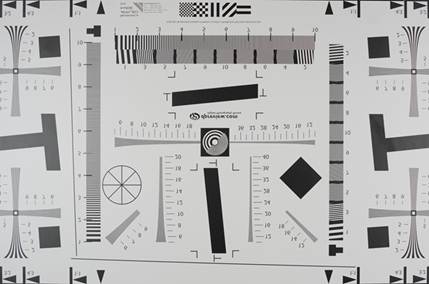
JPEG (4,912 x 3,264)
3.4MB
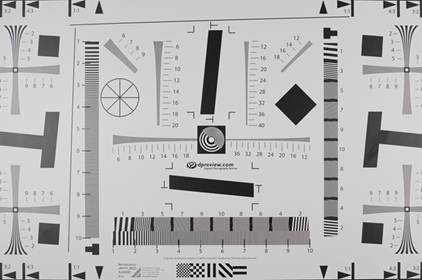
Raw (4,912 x 3,264)
5.3MB
Vertical resolution
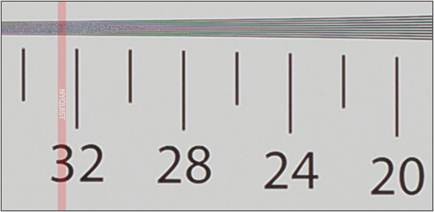
JPEG
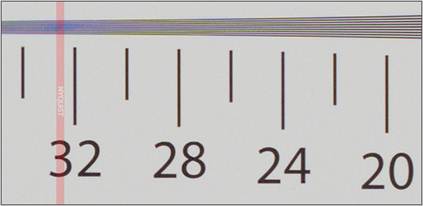
RAW
Horizontal Resolution
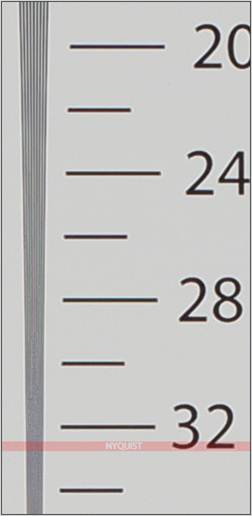
JPEG
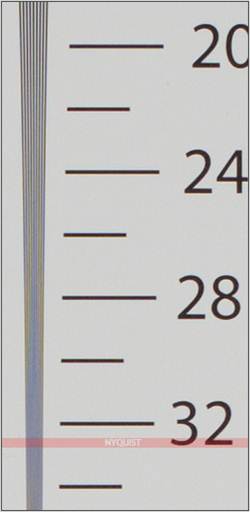
RAW
The results in the resolution chart defer from the
last-generation NEX models that we tested, the NEX-5N. The resolution is almost
identical, showing nine separate lines until about 2,300 lph. On the other
hand, the moiré effect is much more pronounced on the NEX-6, which may be due
to a lighter AA filter. You'll notice this effect less in JPEG images than in
RAW ones; however you will also get the clearer haloing rather than clumsy
sharpening.
ISO Accuracy
The real sensitivity of each marked ISO is measured using
the same images as are used to measure ISO noise levels, we simply compare the
exposure for each photo with the measured brightness level (using a calibrated
Sekonic L-358); middle gray is combined. We estimate the accuracy of the
results to be +/- 1/6 EV (the error margin given in the ISO specifications). It
should be noted that these tests are based on the sRGB JPEG performance of the
cameras, corresponding to ISO 12,232:2,006, the standard used by camera
manufacturers.
Through our testing, the measured noise of the NEX-6 is
approximately 1/3 stops higher than indicated (for example, the images are
somewhat brighter than expected for any given suite of exposure values), which
is within the tolerance level allowed by the ISO parameters.